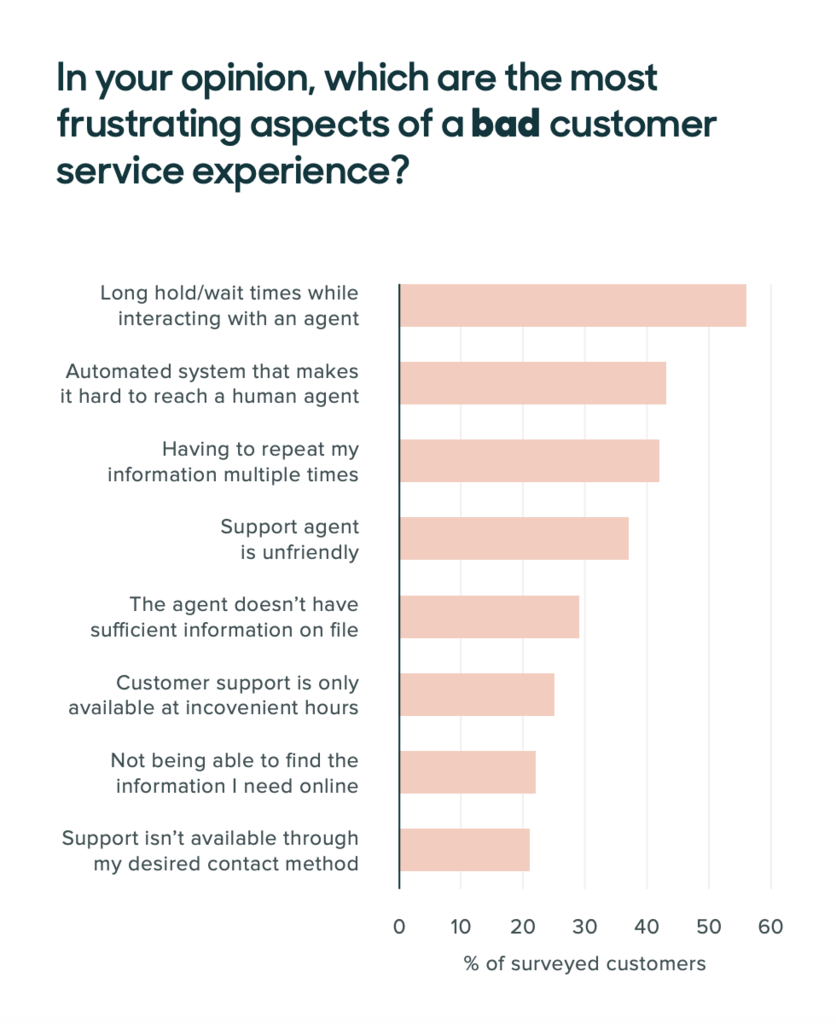5 Common Types of Customer Complaints and How to Handle Them Smoothly

Table of Contents
No one likes to be on the receiving end of complaints. However, in the world of business, it is important to deal with customer complaints. They can be a real teachable moment for those willing to pay attention.
Crucially, they can help a brand improve the customer experience they offer their customers. Mastering the art of handling complaints is what can set you apart from the rest of the competition. It can also lead to increased customer satisfaction and minimized customer churn.
In this article, we will be outlining five common types of customer complaints and how to handle them.
Before we do this, though, let’s go through some general guidelines when it comes to dealing with customer complaints in general, which can help to deliver great customer service and memorable customer experiences.
Be open and friendly - show that you care and are invested
Whether aiming for global experience or locally, a customer is more likely to be appeased when they feel that you genuinely want to help. Encourage them to tell you about their issues and make sure to ask questions. This is beneficial on two levels. Firstly, this will allow you to gather the information necessary to better assist the customer. Secondly, it shows the consumer that you are invested and looking to solve the issue at hand.
Make an effort to communicate as clearly as possible
Effective communication can be the difference between a terrible customer service experience and a great one. Clear communication allows the customer the space they need to express themselves and feel heard. It also increases the chance of successfully de-escalating or resolving the situation smoothly.
Now that we’ve discussed some general tips, let’s look at five common customer complaints.

5 customer complaints and how to tackle them
The service or product is unavailable or out of stock
Generally, if a product is out of stock, it is a positive sign - your customers like it! However, keeping them waiting for too long is never a good idea.
If a consumer has approached you complaining that they cannot get a hold of your product, reassure them by letting them know that they will be notified when the item will next be available so that they can make sure they do not miss it.
If you have discontinued a product or are no longer providing the service they are after, your approach will obviously need to be a little different. The best way to tackle this is to apologize and redirect the customer to another product or service that your brand offers.
For this to be effective, you need to ask customer satisfaction questions and find out what needs the product they originally wanted would have met. Then, you can find the most appropriate service or product to fulfill those needs. Finish this off by explaining how it would be the same as, if not an improvement on, what they originally wanted to purchase.
Poor product or service
When you receive a complaint from a customer about a poor service or product, it doesn’t necessarily mean that it is faulty. However, it is crucial to ascertain where the issue originates from.
If the problem is the product or service, this can be handled with an apology and, in the case of a product, a replacement. If it is a service that you are providing, you can offer a discount or offer a free subscription for a certain amount of time as a gesture of goodwill.
Complaints can also flag up actual issues surrounding your product. For example, if you have been getting an increasing amount of complaints about a service you provide, there are different types of software testing tools at your disposal which can be used to check whether your product or system works effectively and without fault.

Other times, the issue can instead be with the customer. They may unknowingly be using the product wrongly, or mistakenly think that it includes certain features. This can easily happen when there are several models or versions of a product.
Dealing with this type of issue involves teaching your customer about the product or service. Make sure to explain to them how to correctly use it without sounding condescending, accusatory, or making them feel stupid, which is a common customer experience mistake to avoid.
You can also direct them to helpful and appropriate resources. Say a customer has subscribed to your calling platform, but they are struggling to figure out how to set up a conference call. When confronted with the painful process of walking them through it step by step over the phone, a YouTube video showing them how to use the service would be a godsend.
Call hold time is too long
Nowadays, there is an array of channels through which a customer can contact you. Additionally, consumers like to resolve issues themselves. This means that by the time they are calling, you can bet that their frustration levels are already high. There is nothing worse, at that point, than being subjected to on hold music for the next half an hour.

As shown in the graph above, almost 60% of customers feel that being on hold is the most frustrating aspect of a customer service experience.
This proves just how important metrics such as call ASA (average speed of answer) are when it comes to ensuring an excellent customer experience. Metrics like these can help you determine whether you need to implement strategies to improve your ASA.
When a customer complains about the call hold time, the first thing to do is apologize for the delay in answering. Be sympathetic and understanding. Explain that you appreciate their feedback and are working on solutions to resolve this issue.
Looking deeper into the issues, receiving complaints about long wait times indicates that you may be understaffed and need to hire more people to keep up with demand. It can be useful to investigate whether there are any peak times during which customers seek to contact you. You can then use this information to tailor your staff’s schedule to match it.
You may also need to reassess the self-service technology you offer. If you don’t, it could be time to think about it, since 70% of customers expect a company to have a self-service portal or content available.
If you do, then consider optimizing it so that customers don’t need to contact you as often. For instance, if you notice that a certain comment or complaint pops up frequently, you can address it in your FAQs. This will take pressure off your customer service representatives.
To do this well, however, ensure that you have a robust website that is easy to navigate, and steer clear of redirect mistakes to make it more user-friendly and attractive for your customers to use.

Another useful idea is to set up an automated call system that, based on customers’ complaints or issues, can point them to the most appropriate resource. This saves time and can lead to less frustrated customers.
For example, a customer may be calling to ask about the status of their order, which they can check on your website. Your automated call system can redirect them to the relevant website page, thereby saving them from waiting on hold. This gives them the ability to resolve their own queries quickly and is a way of using customer service psychology to deliver better support.
Repeating information
On par with listening to on hold music for what seems like an eternity, having to repeat yourself over and over again to three or four different people, when all you want is a solution, is a special kind of torture. A lack of communication between agents or teams can lead to a bumpy customer experience. So, how do we handle this?
Do not, I repeat, do not transfer them. They’ve likely been through multiple transfers at this point, and transferring them again will just compound their frustration. They may even hang up. As always, apologize, and assure them that their feedback is appreciated and that you are working towards a solution.
Which solution could this be?
Implement a system such as a cloud phone system, which allows you to establish a line of communication between your customer service representatives to ensure the provision of a seamless experience for the customer. Ideally, this software would also allow staff to store relevant information about the clients, which could then be accessed by any relevant staff member when interacting or dealing with said customer.

The representative or agent was not friendly
Representatives represent your brand and can make or break a customer’s positive opinion of your business through their interaction with them.
The best way to handle this kind of complaint is to apologize and assist them as much as possible by going above and beyond and, depending on the situation, possibly extend a gesture of goodwill.
Beyond this, you may want to look at the training you provide your staff and offer a refresher course. It would also be a good idea to take the particular individual aside and explain where they went wrong and how they can avoid this issue next time.
Takeaway
The mention of a customer complaint can send some people running for the hills, but they are a healthy part of any business. The key is knowing how to handle them professionally and make the best of the opportunities they offer. You can look further into related topics, such as Voice of Customer (VoC), to improve your business and streamline your customer service along with the customer experience your brand offers.

Jenna Bunnell
Senior Manager for Content Marketing, Dialpad
Jenna Bunnell is the Senior Manager for Content Marketing at Dialpad, an AI-incorporated cloud-hosted unified communications system that provides valuable call details for business owners and sales representatives. She is driven and passionate about communicating a brand’s design sensibility and visualizing how content can be presented in creative and comprehensive ways. Jenna has also written for sites such as Agile Business and CrankWheel